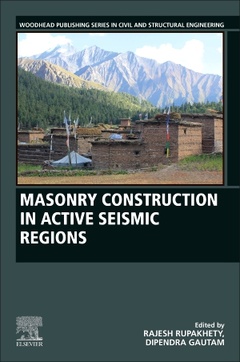Masonry Construction in Active Seismic Regions Woodhead Publishing Series in Civil and Structural Engineering Series
Coordonnateurs : Rupakhety Rajesh, Gautam Dipendra

During earthquakes, masonry buildings are the most affected, and consequently, damage to these buildings leads to massive loss of life and property. Masonry buildings comprise probably the greatest share of overall housing stock, and in turn, understanding their performance during earthquakes is a pivotal problem in seismic regions. Masonry Construction in Active Seismic Regions presents details on the kinds of masonry building found in seismic regions of the world. The title describes interventions, such as retrofitted solutions, dynamic identification, and improved construction after earthquakes, that are equally applicable to regions of moderate and high seismicity. The book covers representative masonry buildings from active seismic regions, the material properties of masonry construction, numerical modelling techniques and computational advances, seismic performance of non-engineered masonry buildings, resilience in typical construction, retrofitting, and the cultural values and structural characterization of heritage masonry buildings in active seismic regions. This book is unique in its global and systematic coverage of masonry construction in seismic regions.
1. Testing and experimental simulation of seismic behavior for modeling and seismic resistance verification of masonry buildings Miha Tomazevic
2. Seismic vulnerability of Himalayan stone masonry: Regional perspectives Dipendra Gautam, Rajesh Rupakhety, Rabindra Adhikari,Binay Charan Shrestha, Rewati Baruwal, and Lalit Bhatt
3. Traditional timber-laced masonry construction in Turkey known as himis¸ Polat G€ulkan and Randolph Langenbach
4. Traditional earth construction in Latin America: A review on the construction systems and reinforcement strategies Pilar Baquedano, Rafael Rami´rez Eudave, Fabiana N. Miranda, Sandra Graus, and Tiago Miguel Ferreira
5. Nondestructive testing, assessment, and strengthening for reducing the seismic vulnerability of masonry structures Tiago Miguel Ferreira, Nuno Mendes, Rui Silva, and Paulo B. Lourenco
6. Geometrical, constructive, and mechanical characterization of the traditional masonry buildings in the historic city center of Leiria, Portugal Tiago Miguel Ferreira, Javier Ortega, and Hugo Rodrigues
7. The Borbone’s antiseismic system: Historical, constructive,and structural analysis S. Galassi, E. Pagano, N. Ruggieri, G. Salerno, and G. Tempesta
8. Seismic vulnerability of historical constructions in Northern Southeast Asia (Indochina): Lessons learnt from recent earthquakes Teraphan Ornthammarath, Saw Htwe Zaw, Nakhorn Poovarodom, and Yin Myo Min Htwe
9. Structural characteristics of Nepalese pagoda temples Manjip Shakya and Jeevan Gwachha
10. From Tship Chim to Pa Chim: Seismic vulnerability and strengthening of Bhutanese vernacular buildings Nimesh Chettri, Dipendra Gautam, and Rajesh Rupakhety
11. Local out-of-plane failure modes in traditional block-masonry buildings Claudia Casapulla
12. Mexican colonial churches: structural assessment and seismic behavior Fernando Pena, Marcos M. Chavez, and Natalia Garcia
13. Features and seismic response of large masonry structures:A case study of Singh Durbar main building, Nepal Rishi Ram Parajuli
14. An engineering view on the traditional timber frames with infills in Romania Andreea Du?u
15. Dynamic characteristics of Inca’s stone masonry Carlos Cuadra
Dipendra Gautam is a researcher in structural earthquake engineering. He has published more than 30 papers and refereed book chapters in top-tier journals and edited volumes. He works in the range of structural earthquake engineering including structural dynamics, seismic vulnerability and reliability analysis, sustainable structural engineering, vernacular seismic resistant construction technologies, risk assessment, among others. He has experience in working after 2011 Eastern Nepal earthquake, 2015 Gorkha earthquake sequence, and 2016 Central Italy earthquake sequence.
- Identifies the material properties of masonry construction from a seismic perspective
- Covers representative masonry buildings from active seismic regions, providing a benchmark to understand existing building stocks
- Provides numerical modelling techniques and reviews computational advances, including a large test database
- Details the seismic performance of non-engineered masonry buildings, as well as the cultural values and structural characterisation of heritage masonry constructions
- Analyses typical or vernacular constructions which have earthquake resilient features, such as Dhajji-Dewari, Borbone, Pombalino, and Himis
Date de parution : 05-2021
Ouvrage de 480 p.
15x22.8 cm
Thèmes de Masonry Construction in Active Seismic Regions :
Mots-clés :
Vernacular construction; heritage construction; brick; stone; masonry; Nepal; earthquakes; seismic performance; non-engineered buildings; earthquake resilience; Dhajji-Dewari; Borbone; Pombalino; Himis; retrofitting; intervention; dynamic identification; computer modelling; numerical modelling; housing



